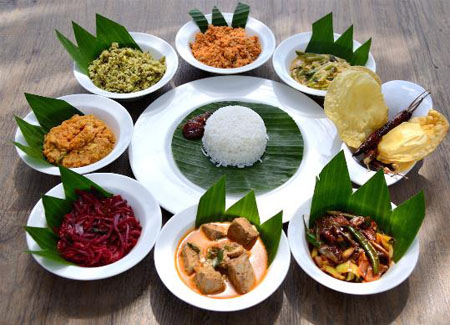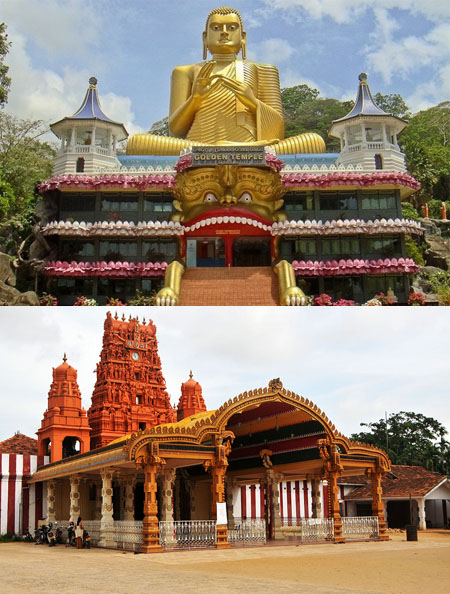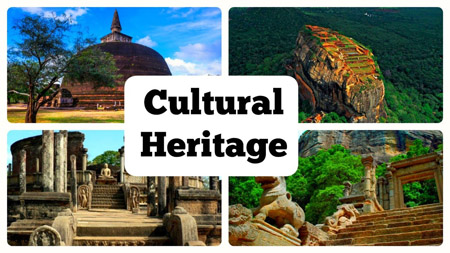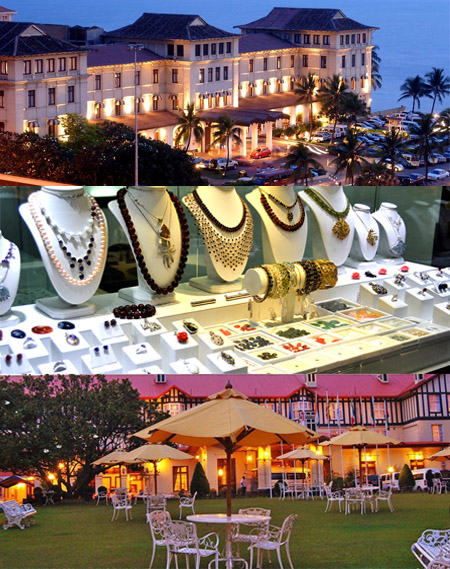Cuisine
Sri Lanka ‘s staple diet is boiled rice & curry, which is generally cooked hot to taste, with all the possible spices. The complete meal is accompanied with parripu (red lentil dals), vegetables, green leaves (lightly stir- fried), Sambol (a mixture of grated coconut, chilly, and spice) fishor chicken in curry. As Meats are also a popularity, beef & mutton are also available.
Sri Lankan cuisine has been influenced by history of the country. Hence there is predominant feel of the Portuguese, the Dutch, the Malays, the Arabs, and the South Indians, all of whom have left their culinary impression on the people of Sri Lanka .
Sri Lanka being of tropical nature has a variety of fruits available. Major among them are: Mangoes, papayas, passion fruit, bananas, jackfruits, durians, rambutans, and mangosteens.

Culture
Sinhalese form the majority ethnic group in Sri Lanka who practice Buddhism. Following them are the Tamil who are majority Hindus. The rest of the people in Sri Lanka either Muslims or Christians.
Sri Lankan society was dominantly influenced by the caste system. Caste system in believes that every person is born into a particular group which defines his or her fixed position within society for lifetime. Purity is an important concept of caste system. Each one is expected not to associate with the lower caste to preserve their purity of their caste. In Sri Lanka there are two caste systems, one for the Sinhalese and the other for the Tamils. For the Tamils, Hinduism is a perpetuated influence on social division among themselves. Now though this system is diminishing,its existence is also seen based on the hereditary roles and functions.
Srilanka’s art & architecture are majorly influenced by Buddhism. There are beautiful structured stupas all around the country side of Sri Lanka . Beautiful large Buddha’s sculptures are found at Aukana, Buduruvagala. Portuguese, Dutch & British colonial influences can be witnessed in the architecture of Srilanka .
Ambalangoda is popular for its ritualistic exorcism of ‘devil dancing’, with the use of various colorful masks, & the thumping of the drums. The up country dancers use acrobatics & agility to make a memorable dance performance of the folklore narrative.

………………………………………………………………………………………………………………………………………………..
Heritage Tourism
Cultural heritage tourism is travelling to experience the places, artefacts and activities that authentically represent the stories and people of the past and present. It includes cultural, historic, and natural resources.”
Sri Lanka is gifted with splendid, millennium old memorials and cultural artefacts in its ancient cities. The three demarcating points of the Cultural Triangle are; Kandy, Anuradhapura and Polonnaruwa. The eight world heritage sites are Anuradhapura, Polonnaruwa, Kandy, Dambulla, Sigiriya, the walled colonial city of Galle; the Sinharaja Rain Forest and the Peak Wilderness.
cultural heritage tourism is the fastest growing sector of the tourism industry since there is a drift toward an increase of interest among tourists. This trend is evident in the rise in the volume of tourists who seek adventure, culture, history, archaeology, and interaction with local populace.
Buddhists and Hindus from world over come to Sri Lanka to pay homage to the Sacred Tooth Relic at Dalada Maligawa in Kandy and latter to Ramayana Trails. The Buddhists in Sri Lanka visits sites connected to Buddhism in India. Thus it differs somewhat from tourism in the usual sense. However, these trips are religiously and culturally important to them.

Shopping
Sri Lanka is a shopper’s paradise; one can get from exclusive batiks to unique antique artifacts. The traditional handicraft bares the individual touch of its creators.
Special colors blended beautifully to create exclusive ready to wear clothes, scarves, wall hangings, sarongs etc. in form of Batiks.
A wide variety of hand-woven fabric is abundantly available. These handlooms are also used to make attractive household linen, shirts sarongs & much more found at places like Bare foot Gallery, Paradise Road studio, Kandyan etc.
Fascinating jewellery is found with one of a kind traditional design, made with Silver, Stones, & Gems. Special kandyan designs which were made for the earlier kings are now sold by modern day silversmiths.
Sri Lanka also specializes in a distinctive form of ceramic ware which churns out world famous table ware from companies like Lanka Ceramic, Noritake, Dankotawa etc. These companies have their own exclusive show rooms where from you can also arrange shipment to your countries.


